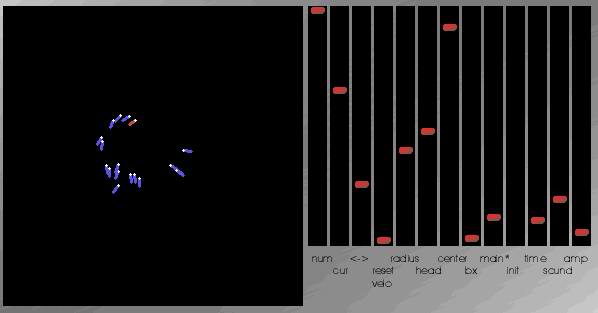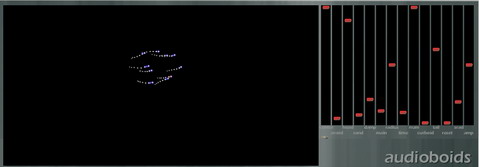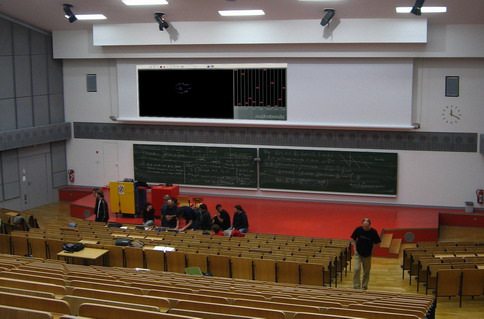Audioboids (2008 wfs version)
July 10, 2008the 2007 stereo boids grew up! After a long summer, the stereo boids decided to make their way back to the flocking grounds of Berlin.
Emergent as they are, they now appear to swarm with much more complexity.
In the most recent version, the audioboids can adapt to a wave field system environment (WFS) together with a SuperCollider engine.
With this option, a 'direct' approach of mapping the visual position data to the audio domain can be achieved.
The presentation took place in the WFS hall of the Technical University Berlin :
Still, they work well with native C++/VST stereo output as well as a control interface for SuperCollider stereo audio synthesis.
This is the data flow of audioboids (2008), including the three possible output options :
Audio Boids (2007 stereo version)
October 23rd, 2007Sebastian Roos is a composer and programmer who is working primarily in the audio domain. The main idea behind his computational arts practice is to develop an associative language in the sonic medium that is capable of representing ideas, architectures, objects or atmospheres of the real world.
His approach as a composer is the same as for the listener - it relies
on the impulsive creation of subjective meaning.
This is constituted by
an understanding of audio space as a boundless and constructable world, that is
created not earlier than in the moment when a listener connects to a mood or a
certain sonic detail within the sound. The listener is projecting his personal
associations into a virtual and imaginary territory, which leaves a freedom of
interpretation confined only by his personal limits. As such, the works - even
if they had a compositional intention in the first place - do not aim to
communicate a dedicated single message that should be squeezed out of the
material.

This device is an implementation of the boids system, realized as Vst-plugin. It projects attributes of the dynamic system sonically as well as to the visual space.
The algorithmic structure of the boids system goes back to Craig Reynolds,
who invented and described the model back in 1986.
Of special
interest is the fact that such a dynamic and unpredictable group behaviour is
not a result of a complex steering mechanism for the whole swarm, but one that
relies only on few rules that apply to each single boid : seperation, alignment
and cohesion.
Fantasies emerge, like those of simple and unified principles
ruling the world, and the questioning of cognitive self-control towards a
mechanical and affect-controlled existence arises.
mapping
One of the major goals was to find an aural representation of the boids
algorithm that ideally reflects the flocking behaviour as immediate as it does
in the visual projection. The mapping of system values to audio parameters was
the critical action for this goal, and several approaches found their way into
the system.
For example, mapping the horizontal coordinate of each boid to
the corresponding point in the stereo panorama is an intuitive approach to
create a representative spatiality. For other parameter mappings, see the
description of the videos.
source material
The basic sonic material was either sine tones or wave files.
The sine
tones had either the same frequency, or were ascending by the harmonic series
for each boid. The wave files could contain arbitrary sonic material, and were
split up in a granular fashion to equip every boid with a slice of the
source.
Ghost stream
October 23rd, 2007While all boids here are of the same base frequency, the slight changes in frequency that are dependent from the distance to the main boid, lead to beating and enhanced roughness. A perfect ambience for obscure nightwalks or power blackouts.
mintech reteched
October 23rd, 2007This approach demonstrates the granular implementation. A short music piece is well shaken and retriggered, resulting finally in a static rhythm pattern because of the looping movements of the boids.
The distance to the main boid is mapped to the playback frequency as well as to the interonset time between successive grains.
Young boids at play
October 23rd, 2007The application allows different settings of amplitude envelopes (attack/release when a boid enters/leaves the sound radius) as well as of the frequency movement (duration and direction).
In this example, a fast frequency movement is applied.
Voiceboids
October 23rd, 2007Another example of the granular implementation.
This time, a human voice is used as source material, with an ascending pitch shift according to the distance. Again, the application reveals its computational origin at the end.
Granular Swarming
October 23rd, 2007The main demonstration for the granular implementation.
Boids make love
October 23rd, 2007It is said, that boids make love only once every 40 years. This delightful moment should not be missed.
boids rule the world [audio]
September 13th, 2007Boid #0 is listening :
 sineshine
[0:29m]: Download/Play
sineshine
[0:29m]: Download/Play ghostpad
[0:53m]: Download/Play
ghostpad
[0:53m]: Download/Play vocal
cords [1:06m]: Download/Play
vocal
cords [1:06m]: Download/Play knatter
[1:04m]: Download/Play
knatter
[1:04m]: Download/PlayThese are first examples of different mapping approaches to an auralization of the boids algorithm. Also the source material varies.



